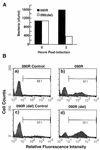Immunization with C5a peptidase or peptidase-type III polysaccharide conjugate vaccines enhances clearance of group B Streptococci from lungs of infected mice
- PMID: 12379721
- PMCID: PMC130386
- DOI: 10.1128/IAI.70.11.6409-6415.2002
Immunization with C5a peptidase or peptidase-type III polysaccharide conjugate vaccines enhances clearance of group B Streptococci from lungs of infected mice
Abstract
Group B streptococci (GBS) are among the most common causes of life-threatening neonatal infections. Vaccine development since the late 1970s has focused on the capsular polysaccharides, but a safe, effective product is still not available. Our quest for a vaccine turned to the streptococcal C5a peptidase (SCPB). This surface protein is antigenically conserved across most if not all serotypes. A murine model was used to assess the impact of SCPB on clearance of GBS from the lungs of intranasally infected animals. Mutational inactivation of SCPB resulted in more-rapid clearance of streptococci from the lung. Immunization with recombinant SCPB alone or SCPB conjugated to type III capsular polysaccharide produced serotype-independent protection, which was evidenced by more-rapid clearance of the serotype VI strain from the lungs. Immunization of mice with tetanus toxoid-type III polysaccharide conjugate did not produce protection, confirming that protection induced by SCPB conjugates was independent of type III polysaccharide antigen. Histological evaluation of lungs from infected mice revealed that pathology in animals immunized with SCPB or SCPB conjugates was significantly less than that in animals immunized with a tetanus toxoid-polysaccharide conjugate. These experiments suggest that inclusion of C5a peptidase in a vaccine will both add another level to and broaden the spectrum of the protection of a polysaccharide vaccine.
Figures





Similar articles
-
Antibody against surface-bound C5a peptidase is opsonic and initiates macrophage killing of group B streptococci.Infect Immun. 2001 Apr;69(4):2302-8. doi: 10.1128/IAI.69.4.2302-2308.2001. Infect Immun. 2001. PMID: 11254587 Free PMC article.
-
Neonatal mouse protection against infection with multiple group B streptococcal (GBS) serotypes by maternal immunization with a tetravalent GBS polysaccharide-tetanus toxoid conjugate vaccine.Infect Immun. 1994 Aug;62(8):3236-43. doi: 10.1128/iai.62.8.3236-3243.1994. Infect Immun. 1994. PMID: 8039893 Free PMC article.
-
Immunization with C5a peptidase from either group A or B streptococci enhances clearance of group A streptococci from intranasally infected mice.Vaccine. 2004 Oct 22;22(31-32):4332-41. doi: 10.1016/j.vaccine.2004.04.030. Vaccine. 2004. PMID: 15474726
-
Glycoconjugate vaccines to prevent group B streptococcal infections.Expert Opin Biol Ther. 2003 Sep;3(6):975-84. doi: 10.1517/14712598.3.6.975. Expert Opin Biol Ther. 2003. PMID: 12943456 Review.
-
Group B streptococcal conjugate vaccines.Arch Dis Child. 2003 May;88(5):375-8. doi: 10.1136/adc.88.5.375. Arch Dis Child. 2003. PMID: 12716700 Free PMC article. Review.
Cited by
-
Surfome analysis as a fast track to vaccine discovery: identification of a novel protective antigen for Group B Streptococcus hypervirulent strain COH1.Mol Cell Proteomics. 2009 Jul;8(7):1728-37. doi: 10.1074/mcp.M800486-MCP200. Epub 2009 Apr 28. Mol Cell Proteomics. 2009. PMID: 19401597 Free PMC article.
-
Non-proteolytic functions of microbial proteases increase pathological complexity.Proteomics. 2015 Mar;15(5-6):1075-88. doi: 10.1002/pmic.201400386. Epub 2015 Feb 6. Proteomics. 2015. PMID: 25492846 Free PMC article. Review.
-
Anchors away: contribution of a glycolipid anchor to bacterial invasion of host cells.J Clin Invest. 2005 Sep;115(9):2325-7. doi: 10.1172/JCI26285. J Clin Invest. 2005. PMID: 16138188 Free PMC article.
-
Characterization of a novel leucine-rich repeat protein antigen from group B streptococci that elicits protective immunity.Infect Immun. 2005 Mar;73(3):1671-83. doi: 10.1128/IAI.73.3.1671-1683.2005. Infect Immun. 2005. PMID: 15731068 Free PMC article.
-
Active and passive intranasal immunizations with streptococcal surface protein C5a peptidase prevent infection of murine nasal mucosa-associated lymphoid tissue, a functional homologue of human tonsils.Infect Immun. 2005 Dec;73(12):7878-86. doi: 10.1128/IAI.73.12.7878-7886.2005. Infect Immun. 2005. PMID: 16299278 Free PMC article.
References
-
- Ablow, R. C., S. G. Driscoll, E. L. Effmann, I. Gross, C. J. Jolles, R. Uauy, and J. B. Warshaw. 1976. A comparison of early-onset group B streptococcal neonatal infection and the respiratory-distress syndrome of the newborn. N. Engl. J. Med. 294:65-70. - PubMed
-
- Baker, C. J., and M. S. Edwards. 1995. Group B streptococcal infections, p. 980-1054. In J. S. Remington and J. O. Klein (ed.), Infectious diseases of the fetus and newborn infant, 4th ed. W. B. Saunders Co., Philadelphia, Pa.
-
- Baker, C. J., N. A. Halsey, and A. Schuchat. 1999. 1997 AAP guidelines for prevention of early-onset group B streptococcal disease. Pediatrics 103:197-198. - PubMed
-
- Baker, C. J., and D. L. Kasper. 1976. Correlation of maternal antibody deficiency with susceptibility to neonatal group B streptococcal infection. N. Engl. J. Med. 294:753-756. - PubMed
-
- Baker, C. J., and D. L. Kasper. 1985. Group B streptococcal vaccines. Rev. Infect. Dis. 7:458-467. - PubMed
Publication types
MeSH terms
Substances
Grants and funding
LinkOut - more resources
Full Text Sources
Other Literature Sources
Medical

